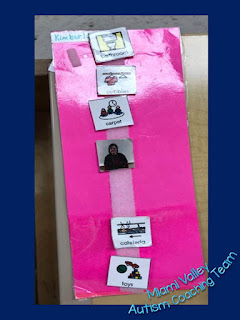Communication is a difficult skill for many of our
referral students and can vary greatly for everyone. Often we see deficits in
our students’ ability to communicate in a functional way. Without functional
communication, students may use unexpected behaviors in an attempt to
communicate or they may try modes that are not easily understood by others such
as vague scripts or words.
It is essential that educational teams help
students develop the ability to functionally communicate. Functional Communication Training is an evidence-based practice which can be very helpful in helping to replace interfering behaviors with meaningful communication strategies. In our newest blog series, Communication Corner, we will be addressing various communication functions and providing strategies for teaching functional communication to address each one. Today's Communication Corner focuses on students learning to request a break to replace escape behaviors.
In our work with teams, we often see students who
exhibit interfering behaviors when they want to escape a setting or activity.
These behaviors may include hitting, running/eloping, flopping to the floor,
screaming, or throwing materials. An important component of addressing these
behaviors is to teach a replacement behavior such as a strategy for
communicating when they want to escape or protest.
Requesting
a Break
When a student is demonstrating unexpected
behavior as a response to frustration during a task, the student can be taught
to request a break. The team will need to determine what activity to use for a
break. It should be less motivating than earned task completion rewards. We
recommend break activities that are calming and are easy to transition off of
to return to the task. If the activity does not have a clear end point, use a visual transition cue to transition the student back to the activity.
Break Card
A break’s complexity may vary dependent upon the
student’s individual needs. For some students, a break will always be the same
activity such as walking to the water fountain to get a drink, sitting in a
bean bag with a fidget for a designated amount of time, complete a deep
breathing activity, or taking their work to a quieter homebase location.
Students may be taught to request this break using a general break card or a
specific picture of the activity.
 |
| Beth Young Snyder Park Elementary, Springfield |
Staff may want to duplicate the break card to use
as a visual cue when they notice signs of escalation and want to cue the
student to take a break.
Break
Sequence
Other students may be able to complete a sequence
of calming activities as their requested break activity. Most sequences provide
the needed break from demands, provide calming input, and have a definite
ending point which makes it easier to transition back to work. The sequence
should be directly taught and regularly practiced during times when the student
is not feeling frustration. For these breaks, the student can use a break card
to signal when they want to do their sequence.
 |
| Taylor Ruef Stevenson Elementary, Mad River |
 |
| Christine Scarborough Tecumseh Elementary, Xenia |
 |
| Rachel Hatton Normandy Elementary, Centerville |
Break
Choice Boards and Folders
Eventually, students may be able to use a break
folder or choice board to determine an acceptable activity to complete during a
requested break. It is important to trial a variety of activities prior to
adding them to the student’s choices to see which the student prefers and which
activities calm them best. Like the previous options, a visual should be
available for the student to request when they need a break.
 |
| Keelin DiMuccio Fairbrook Elementary, Beavercreek |
 |
| Stephanie Foreman South Vienna Elementary, Northeastern |
 |
| Angela Crum Parkwood Elementary, Beavercreek |
 |
| Rebecca Lemons Miamisburg Middle School, Miamisburg |
Sometimes the same visual is used on the student’s visual schedule for them to practice making break choices throughout the day.
Keep in mind when the team decides to use the
break requesting strategy, it needs to be directly taught and student should be
reinforced for requesting a break as an alternative to escape behaviors. Initially,
the break is honored immediately each time it is requested. Once the student is
beginning to demonstrate understanding of the strategy and any escape behaviors
have been eliminated or reduced, the team can work on teaching the skill of
waiting for a break.





























































